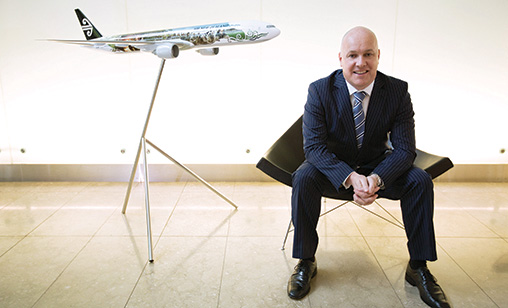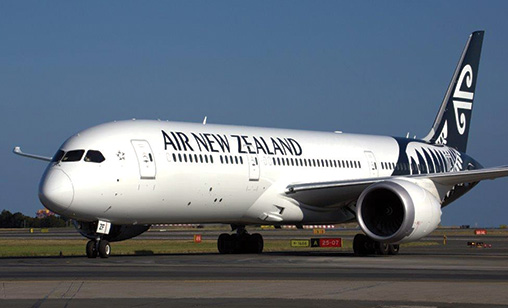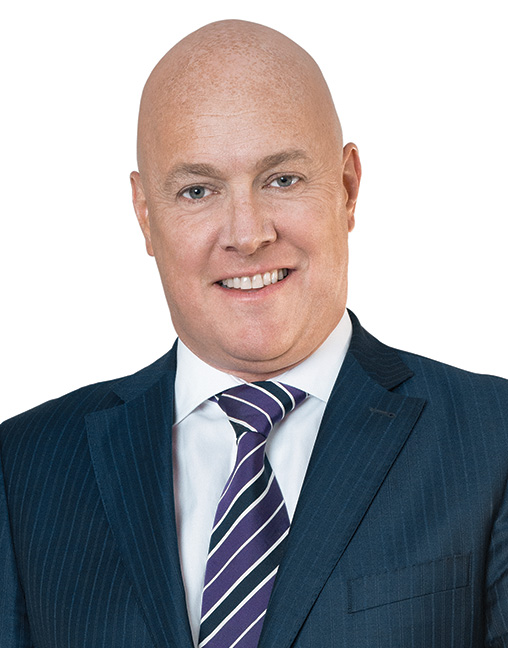Cover Story
FORGING A PACIFIC DESTINY
After a little more than three years in the airline industry, first as group general manager of Air New Zealand’s international arm and then chief executive from January 2013, Christopher Luxon, the former Unilever high flyer, has built on the carrier’s reputation as one of the region’s most successful airlines.
December 1st 2014
It has been a stellar year for Orient Aviation’s 2014 Person of the Year, Christopher Luxon, and his team of “Air New Zealanders”. After less than two years as Air New Zealand’s (Air NZ) CEO, he has reported record profits for the Auckland headquartered carrier as his “Go Beyond” strategy propels the company to greater fiscal and service heights. Read More »
“I don’t see that many challenges. I just see a lot of opportunities,” Luxon said when Orient Aviation asked him what lies ahead for the carrier. “For us, it’s a question of how fast we can secure them and get into them,” he said.
 |
| ORIENT AVIATION PERSON OF THE YEAR 2014 Christopher Luxon CEO, Air New Zealand |
He eschewed the view that New Zealand sits at the end of the earth, isolated from world markets. It is, he insisted, ideally placed to take full advantage of the fast growing markets that stretch all the way round the vast Pacific Ocean.
“Sitting in this Pacific Rim region, there are huge opportunities for us to offer the future massive middle class and rapidly urbanizing large countries around us a great tourism experience in New Zealand,” he said, “as the power moves from the Atlantic to the Pacific.”
“It’s an opportunity for us. It’s how we can develop markets quicker. It’s how we identify what works and rapidly implement it across our network and the entire company. There is nothing out there in the big world that I think is particularly problematical for us and the macro environment,” he said.
Luxon’s record of running the airline confirms his optimism. In the past year, he finalized a revenue sharing alliance with Singapore Airlines (SIA) that will commence next month. In November, Luxon signed a Letter of Intent with Beijing-based Air China for a similar deal that will give the carrier critical access to the Mainland Chinese market.
A B787 customer from get-go, the carrier recently took delivery of the first B787-9 to come off the production line. Its second and third aircraft of the type are scheduled to arrive in Auckland before Christmas.
To top it off, Air NZ reported a big lift in profit, record pre-tax earnings of NZ$332 million (US$262 million) for its 2013-2014 financial year, to June 30, representing meaty growth of 30% over the previous year.
| Cost discipline “There’s a lot to do around good cost control. It’s a mindset of saying: ‘if we spend money in this space is that going to add value to the customer, will they ultimately value it and will they be prepared to pay more for it? Equally, let’s strip out the cost of complexity.” He has brought in a new capability around Lean Six Sigma (a methodology that relies on a collaborative team effort to improve performance by systematically removing waste), continuous improvement tools, strategic rendering and partnering and procurement. “That is having huge advantages for us. We are trying constantly to recover our CPI increases, our costs, each and every year through more productivity, more efficiency. “That’s been great as we’ve been growing the company. That’s expanding the profit, expanding the cash flow and expanding our investment grading, that is freeing up our ability to pay dividends which we have done for the last decade, but we’ve continually increased over the last few years,” he said. “All of that is throwing up the profits to plough straight back into the company to afford the fleet, the lounges, investment for technology and other things. We want to make sure that in this part of the cycle we are as strong as we can be and we are making sure we go on being strong in five, ten, fifteen years from now.” |
It was the carrier’s third straight year of strong earnings growth, underscoring why Air NZ is one of only four airlines in the world to have an investment-grade credit rating. During the year, it carried 13.7 million passengers, up 2.5% over the previous 12 months, with an average load factor of 84.1%.
So, what are Luxon’s secrets of success? Right off, he does not take the credit for the good news. “First of all, we have very good foundations in the business. They have been built over a long period of time, certainly by Ralph Norris and then Rob Fyfe (his predecessors as CEOs at the airline).
A year ago Luxon explained that corporate heritage. “We have had a series of CEOs over the last decade that have come from outside the industry. With that comes a lot of provocation about why we can’t do things differently,” he said.
“So, we have good levels of customer centricity, good reputation, and a very open and innovative culture in the business. We would describe ourselves as being a really good company. We want to become a truly world class, great company.”
Great companies, Luxon said, whether airlines or those in other industry sectors, can deliver superior commercial results and enhance the customer experience while continuing to build and develop their people.
“For us, success at Air New Zealand is very much multi-dimensional, but centred around three core tenets: commercial, customer and culture. We see those things often in tension with each other, but they are actually very interdependent.
“We fundamentally believe if we’ve got highly positively engaged staff, we will have happy customers. If we have happy customers we have a strong business. Likewise, if we can generate good economic returns and cash flows as we’ve been doing, that’s enabling us to rapidly enhance the customer experience. We are investing a lot more in the development of our people and our leadership skills.”
The driving force behind greater success for Air NZ is the company’s Go Beyond strategy, implemented two years ago. Its first tranche focuses on the customer experience and incorporating the values of the brand. It identifies what customers value and what could be new sources of revenue.
The second major tenet of the strategy “is built around market place execution and realizing that if we are going to be focused around the Pacific Rim, that is a huge opportunity for us in Asia, the Americas and Australasia”, said Luxon.
 |
“We want to be with the right partners, in the right markets and with the right execution. A lot of that has been about alliances and how we build our alliance network.
“The third big thrust for us is to be fighting fit. How do we make sure we’re safety first? How do we ensure a seamless journey? How do we strip out cost and complexity in the business that is not adding value and for which our customers do not want to pay?”
The final element of the Go Beyond strategy is building a winning team. “I fundamentally believe everything can be copied about our business except our people. That’s the one difference maker. How do we get a differential effort from our people through better leadership?” Luxon said.
“We’ve learnt a lot about the culture of an organization. Eighty per cent of it is shaped by the actions of leaders. So, if I can invest more in people and our leadership potential that is important.”
Go Beyond has been quite critical for the business, Luxon said. “We don’t want to rest on our laurels and say: ‘aren’t we a great business?’. We need to reframe the business and give it new ambition and new aspiration. Go Beyond has huge traction for us.”
Interestingly, Luxon said Go Beyond is not just about Air New Zealand. “For us, at the heart of our Go Beyond strategy, we have what we call our significance goal. We want to help supercharge New Zealand’s success as a country economically, socially and environmentally.
“We feel a real responsibility to help our country succeed and we take that really seriously. Our people understand they are ambassadors for New Zealand. We have a mission and purpose to the business that’s bigger than just making money.”
Nevertheless, profits are obviously important. Luxon outlined to Orient Aviation the carrier’s “success goal”, which is about doubling the airline’s profits.
| The fuel view Luxon said the recent drop in the oil price is of assistance, but some of these gains have been cancelled out by a devaluation of the NZ$ against the US$. “We have a very good hedging policy,” he said. “And to be honest, unlike many airlines, we don’t get that obsessed by it. It’s a good situation to be in, but I think there has been an over-reliance by airlines on building their business around fluctuating fuel prices. “We put together our business plan each year assuming fuel will be at $125-$127 per barrel and then we cut our cloth - our business - so we can assume that is a reality. For me, the bigger issue is that it gives people false security. They believe they are running a good business because they get a windfall benefit of fuel. “I’m more interested in the underlying economics and the health of the business rather than the benefit received from a lower commodity fuel price. Lower fuel prices will spur the global economy. My observation is airlines get lazy and complacent when fuel goes low and don’t do the work on their businesses. In fact, that’s the time to do work to ensure you are fit for when it goes high again.” |
“In the last two years, we have doubled profitability. We are on the right track. We need to improve profitability to afford our big fleet investments. We have $2.2 billion (of aircraft) coming in the next four years,” he said.
“We have $50 million in lounge developments this year. We have a lot of IT systems and technology applications to be rolled out. And we have a big investment in customer service training as well. None of this is possible if we don’t get that economic engine moving right.”
On the operational front, the airline has developed a strong portfolio of alliance partners. Apart from its Star Alliance membership, its deepened relationship with Singapore Airlines (SIA) will result in Air NZ flying to Singapore for the first time since 2006, using a refurbished B777-200. The expanded partnership will open up 58 new destinations for Air NZ through SIA and Singapore to Southeast Asia, Europe and India.
Negotiations to conclude a similar deal with Air China are expected to be finalized early next year and then submitted for regulatory approval. The proposed alliance will see Air China operate a new direct Beijing-Auckland route in addition to Air New Zealand’s existing Shanghai-Auckland service. Along with its alliance with Cathay Pacific Airways, the Air China partnership will enhance the airline’s presence in Greater China.
The carrier also has alliances with All Nippon Airlines, United Airlines and Air Canada.
Its 25% equity in Virgin Australia provides network coverage across Australasia. Luxon serves on the Virgin Australia board.
He described the pending deal with Air China as “a really exciting thing” because the two countries have a special relationship. New Zealand was the first nation to recognize China in the World Trade Organization (WTO) and the first country to receive approved destination status from China. New Zealand sealed its first free trade agreement with Beijing six years ago.
“We have a long history of working with China. It’s been a very successful one, to the point where China is our biggest trading partner and our second biggest source of foreign visitors after Australia,” said Luxon.
 |
| 'I love the industry. I’ve been in the airline industry for just over three years and it’s incredibly addictive. It’s just an incredibly fun, challenging and stimulating industry to be part of. Infinitely more interesting than where I’ve come from, I think' |
| Christopher Luxon CEO Air New Zealand Orient Aviation Person of the Year 2014 |
There are likely to be more alliances. “We are very interested in opening up South America. Really the big opportunity is about South America. We are looking very closely at it,” he said.
The carrier’s fleet plan is rapidly coming together, with the arrival of the B787-9s bringing new levels of economy to fleet operations. After the third Dreamliner arrives this month, there will be seven more to come.
The first B787-9 is flying between New Zealand and Perth, with occasional services to Sydney and other eastern Australian seaboard cities. The second Dreamliner began flying to Shanghai from Auckland on November 4. The third will operate on the Auckland-Tokyo route.
“The -9 is performing incredibly well for us. It’s a fantastic aircraft. We had high expectations for it and it’s performing slightly higher than we even thought it would,” said Luxon.
Air NZ has a jet fleet of 49 aircraft (50 with the B787-9’s arrival this month). It comprises 23 A320s for domestic and regional flying, 4 B737s, 5 B767s, 8 B777-200ERs and 7 B777-300ERs, along with the B787s. It has ordered 5 A320s and 13 A321neos.
“Our big challenge with our wide-body fleet has been consistency. I’m sure it’s a challenge for many airlines, but we had such an odd, inconsistent fleet. We were determined to put in place a fleet where the same product is available on every single aircraft,” he said.
That product includes business class lie flat beds and an innovative premium economy class. The carrier’s unique SkyCouch allows some economy cabin passengers, for a additional charge, to convert three economy seats into a lie flat bed. It is already on the B777-300s and the B787s. Some $120 million is being spent refurbishing the B777-200s to the same standard. AirNZ has licensed the product to China Airlines, who will fit it on their B777-200ERs.
“We will end up with a fleet of B777s and B787s, of one type rating with a lot of operational synergies and efficiencies, but very good fuel burn and a very good customer experience. That’s the end game we talk about achieving,” Luxon said.
Amidst all of this, he keeps a keen eye on the carrier’s cost base. Its unit costs have been coming down because the airline has adopted a constant cost reduction programme, benchmarking itself against the best-in-class low-cost carriers. The idea is to work on continuous improvement rather than having blueprint cost control programmes.
“Coming from outside the airline industry, I would say cost control is something that airlines in general do quite poorly relative to other industries. Our view has been that in many ways people in the airline industry would like to blame macroeconomics for our issues and the performance of our businesses,” he said.
Luxon has no regrets about ending his long career at Unilever, where he was president of Unilever Canada, based in Toronto, and was responsible for leading that company’s $1.4 billion Canadian business and 1,500 employees. He was also a key member of Unilever’s North American Leadership Team.
| ORIENT AVIATION WILL PRESENT MR LUXON WITH HIS 2014 ORIENT AVIATION PERSON OF THE YEAR AWARD AT A GALA RECEPTION AT THE AUCKLAND ART GALLERY IN JANUARY. SPONSORED BY AIRBUS |